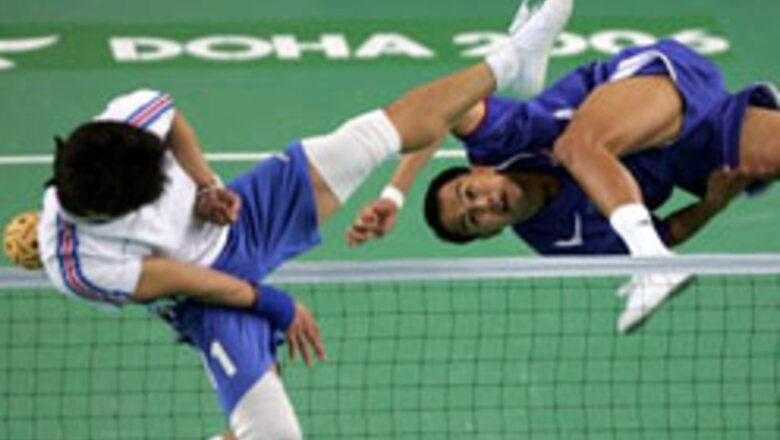
views
Doha: Sepak takraw. Wushu. Kabaddi, kabaddi, kabaddi.
The Asian Games, a kind of mini Olympics for the world's most populous region is a showcase of the best athletes Asia has to offer. It is also a showcase of some sports so obscure outside their homelands that they are giving even Asia a touch of culture shock.
"It's amazing," Carol Duffy, a British citizen living in Qatar, said after watching her first game of sepak takraw, one of the uniquely Asian sports at the games. "It's very, very different."
To say the least.
Sepak takraw, played primarily in Thailand and Malaysia, is like volleyball, but with a no-hands rule. Three players cover the court, which is divided by an eye-height net. They serve, save and spike, often while airborne with their feet. And to give it a little more soccer flavor, they can also use their heads, shoulders and chests to keep the hollow, woven ball aloft.
The game dates back some 500 years, when the object was just to keep a rattan ball in the air as long as possible. Later on, a net was added and a set of formal rules established in 1960. The introduction of a synthetic ball in 1984 added a new element of speed.
It's now a staple of the Asian Games, though Thailand still usually win.
"It's a new sport for us, so it's really interesting," said Indian sepak takraw team member Gajendran Gayathri, who first saw the sport just five years ago. "You spike, you do somersaults. You have to be really flexible."
Then there's kabaddi.
Probably the closest counterpart for this sport outside of its native India is playground tag.
Kabaddi is played between two seven-member teams on a court with a line drawn down the middle.
A "raider" from one team is sent to the opposing half, all the while chanting "kabaddi, kabaddi, kabaddi" on one breath, inhaling during a raid is against the rules. Raiders score points by touching players from the opposing team and getting back into his own half without being caught or tackled to the ground.
If the catchers manage to prevent the raider from returning to his side of the court, their team gets the point.
Because it is cheap and easy to play, kabaddi is a staple in rural parts of India, Pakistan, Nepal and Sri Lanka. It has been recognised as the national sport of Bangladesh since 1972.
PAGE_BREAK
But it's pretty much unheard of anywhere else, even the rest of Asia.
For the Asian Games, Japan sent a bunch of Buddhist monks, who were attracted to kabaddi because of its meditation-like chanting.
"Kabaddi represents sport in its purest form, underscoring the philosophy of simplicity," said Shojun Shimizutani, who caught his first glimpse of the game when studying Buddhism at Taisho University in Tokyo.
Though it remains something of an oddity to everyone else, the Indians take their kabaddi very seriously, and they've won all the golds in the event since it was introduced at the 1990 Asian Games in Beijing.
The martial art of wushu is China's contribution to the games.
The most artistic of the fighting sports, wushu focusses on "taolu," elaborate set routines, with or without weapons like spears and swords, more than on actual sparring, or "sanshou." Competitors wear shiny silk uniforms, often in bright colors, to add to the aesthetic effect.
Wushu this year is joined by Japan's karate, an offshoot of the Chinese martial tradition at the Games. The longtime Olympic sport of judo wrestling is also on the Asian Games' lineup, along with the Korean martial art of taekwondo. It is rumoured that China want to follow the Japanese and South Korean example by pushing wushu as an exhibition sport when they host the Olympics in 2008.
The Asian Games are a good stepping stone.
Held every four years, the Games bring together more than 10,000 athletes seeking some 400-plus gold medals in the region's biggest sports extravaganza. The competition is held along the Olympic model and centers on well-known sports such as soccer and swimming that are played around the world.
For many spectators, the inclusion of non-Olympic regional sports is what gives the Asian Games its charm. For the athletes, however, seeing their sport in the Olympics is a common dream.
"It would be really great if we were in the Olympics someday," said Murvgesh Purvaja, another of India's sepak takraw players. "It's the kind of sport that if you see it you want to play it."
But she added: "I don't think we will ever make it to the Olympics."



















Comments
0 comment